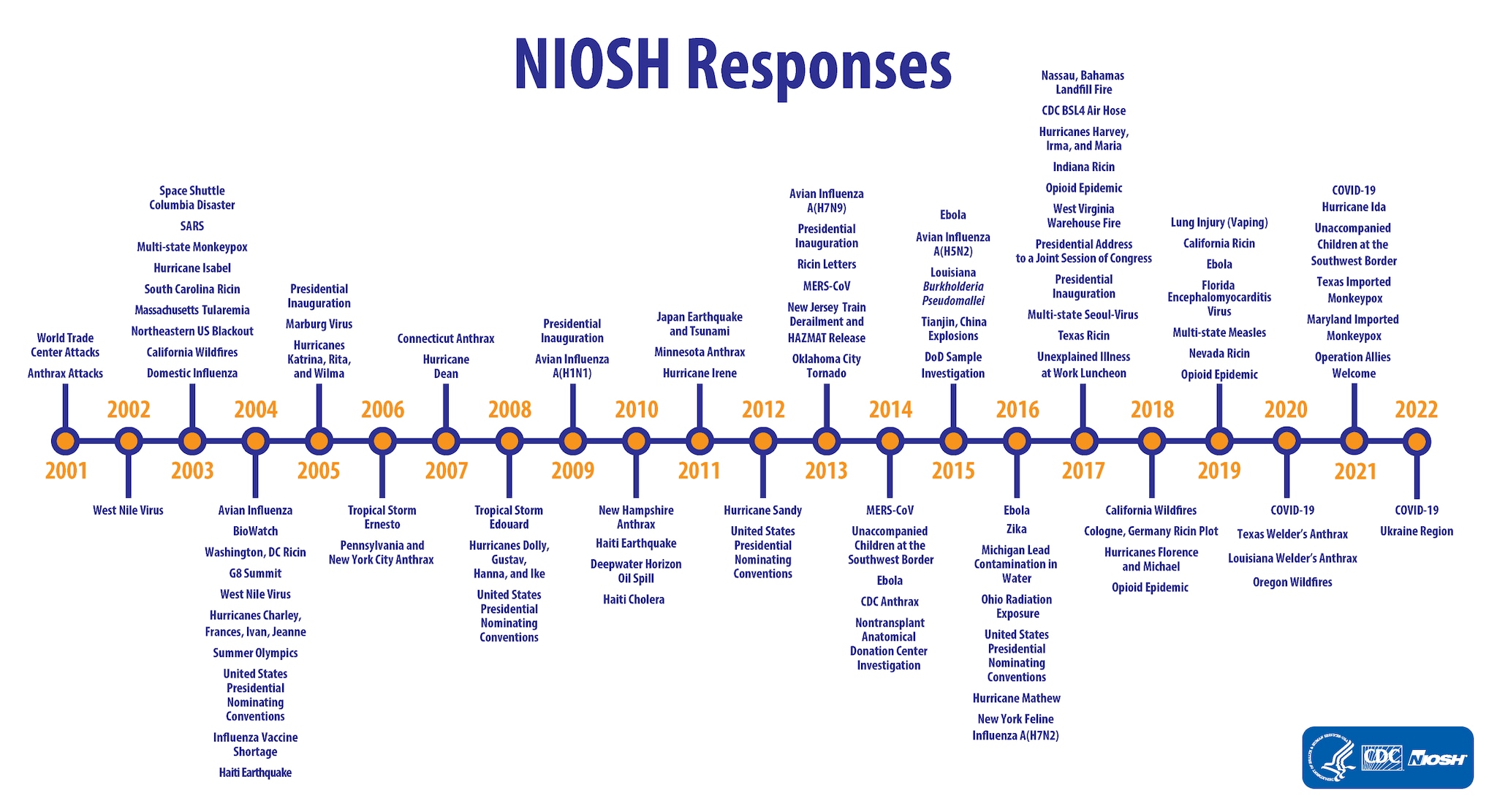Emergency Preparedness and Response Program

The Emergency Preparedness and Response (EPR) Program prepares for, responds to, and researches chemical, biological, radiological and natural disasters. The program integrates and evaluates occupational safety and health topics to protect response and recovery workers.
DSRR COVID-19 Research Agenda
The NIOSH Disaster Science Responder Research Program (DSRR) has developed a COVID-19 research agenda to address occupational health research gaps in the context of the ongoing response. This research agenda is a high-level framework for planning and prioritizing COVID-19 research recommended, conducted, or supported by NIOSH.
FEMA offering trainings of the NIOSH Emergency Responder Health Monitoring and Surveillance (ERHMSTM) framework
The Federal Emergency Management Administration (FEMA) has incorporated ERHRMS framework into their Disaster Related Exposure Assessment and Monitoring course. For more information, visit FEMA’s national preparedness course catalogue.
NIOSH Emergency Preparedness and Response (EPR) program integrates occupational safety and health into emergency responses during planning and preparedness activities to protect response and recovery workers. The Emergency Preparedness and Response Office (EPRO) manages much of this work and coordinates with other NIOSH programs that conduct research in this area. EPRO functions as the coordination point for all NIOSH emergency preparedness and response activities and provides occupational safety and health assistance during emergencies. The EPRO staff is educated and experienced in the fields of industrial hygiene, environmental health, epidemiology, and emergency response.
Specifically, EPRO:
- Provides guidance and recommendations during emergencies
- Supports CDC emergency response effort
- Participates in response planning, training, and exercises the local, state, national, and international levels
- Promotes responder health and safety through the Emergency Responder Health Monitoring and Surveillance (ERHMSTM) Program
- Promotes and facilitates research through the Disaster Science Responder Research (DSRR) program
The Emergency Preparedness and Response (EPR) program priorities are strongly shaped by current events. The unpredictable nature of emergency response work means the program must remain flexible and be responsive to new focus areas and objectives that emerge from newly issued federal policy, plans, and initiatives; responses to emergencies; national level exercises; and emergency supplemental funding. EPR’s work supports all seven of NIOSH’s strategic goals and is integrated into the NIOSH Strategic Plan in two places. First, the Emergency Preparedness and Response Office (EPRO), which manages much of the work of the program, has a set of service goals that reflect ongoing efforts to enhance worker safety and health during public health emergencies and recovery activities.
Second, EPRO contributes to NIOSH research goals. The Disaster Science Responder Research (DSRR) Program within EPR seeks to promote and support timely and scalable responder-based disaster research. Therefore, the work intersects with several sector and cross-sector programs within the NIOSH Program Portfolio. EPR helped develop several of the shared research goals in the NIOSH Strategic Plan, to improve safety and health among first responders in public safety and healthcare workers in the front line of emergency response. Other research goals are around industries that help in recovery efforts, including construction; transportation, warehousing, and utilities; and agriculture.
| Sector | Goals |
| Public Safety |
|
| Healthcare and Social Assistance |
|
| Construction |
|
| Transportation, Warehousing, and Utilities |
|
| Agriculture |
|
Program Review
In 2018, the EPR program underwent external review by an independent panel of experts. EPR was assessed on relevance and impact of the program’s work in the areas of Emergency Responder Health Monitoring and Surveillance™ (ERHMS™), anthrax preparedness and response capabilities, and other emergency preparedness activities and responses. The program received a score of 10 out of 10 (5 for relevance and 5 for impact). More information, including the evidence package prepared by the program, the report written by the review panel and the program’s response to the panel’s report, are available on the Evaluation of NIOSH Programs page.
Response Efforts
EPRO has responded to numerous responses, participated in exercises, and improved response planning and preparedness over the past decade.

Emergency Preparedness and Response Resources
This directory provides links to additional information on a range of emergency types as well as resources for emergency responders.
Disaster Science Responder Research (DSRR)
EPRO established the DSRR program to identify research gaps and to promote quality research in disaster science. The goal of DSRR is to develop and implement a framework to allow for timely occupational health and safety research, without interfering with responses NIOSH EPRO also seeks to address occupational safety and health gaps identified in past responses and initiate research to address them.
Emergency Responder Health Monitoring and Surveillance (ERHMSTM)
EPRO developed the ERHMSTM program after the 2001 9-11 attacks demonstrated the need to better track the health and safety of emergency responders throughout the pre-deployment, deployment, and post-deployment phases of an incident. EPRO also developed and released a free software tool, ERHMS Info ManagerTM, that allows response organizations or leadership to track health and safety data on all individuals participating in an incident and to ultimately implement the ERHMSTM framework within their respective organizations.
Emergency Response Safety and Health Database
The Emergency Response Safety and Health Database (ERSH-DB) is a rapidly accessible occupational safety and health database developed by NIOSH for the emergency response community. The ERSH-DB contains accurate and concise information on high-priority chemical, biological and radiological agents that could be encountered by personnel responding to a terrorist event.
Contact
Contact CAPT Lisa Delaney, Associate Director for Emergency Preparedness and Response, at nioshepro@cdc.gov with any questions
